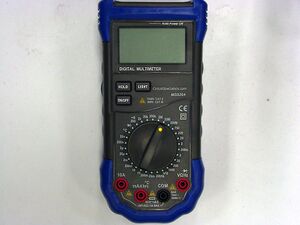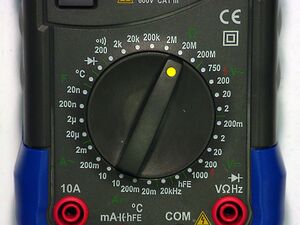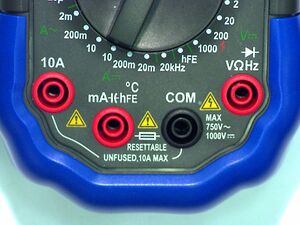MS8264
The MS8264 is a digital multimeter.
Specifications
The following list is taken from a previous spec sheet available from Circuit Specialists:[1]
- DC Voltage: 1000 V
- AC Voltage: 750 V
- Temperature:-20°C to 1000°C (32°F to 1832°F)
- Data Hold and Backlight
- Capacitance: 2nF - 20µF (new model starts at 20 nF)
- Resistance: 200 $$\Omega$$ - 200 M$$\Omega$$
- DC Current: 20 mA - 10 A
- AC Current: 2 mA - 10 A
Use
To use the DMM, first set the dial (picture at top right) to both the quantity and the range desired. From the top going clockwise, the measurements that can be taken are resistance (\(\Omega\)), AC voltage (V~), DC voltage (V-), transistor testing (hFE), frequency (20 kHz), DC current (AC-), AC current (A~), capacitance (F), temperature (deg. C) and diode test (diode symbol). Note that within most of these, several maximum values are selected; choose the setting that gives the greatest precision for your measurement. For example, measuring DC voltages that should peak at 5 V would mean choosing the DC Voltage 20 setting, since 2 is too small and 200 is larger than it needs to be.
Second, connect the test probes to the correct terminals (picture at bottom right). Important Do not try to force the probes into the terminals; the terminals are only soldered into the circuit board contained within the DMM and are rather fragile. Instead, apply gentle pressure and twist the probe end slowly back and forth until it is connected.
For certain types of measurement, you will need to use the MS3206 Multi-Function Socket. Specifically, when measuring the hFE value of a transistor or when measuring temperature, make sure the COM plug of the multi-function socket is connected to the black terminal and that the + plug is connected to the terminal. Also, for temperature measurements, you will need to use the Type K thermocouple provided with the DMM.
For the rest of the measurements, the black test probe should be connected to the black COM terminal. The red probe will be connected as follows:
- 10A - only used when measuring AC or DC current in the 10 A range. It is highly unlikely that you will need to perform measurements like this in the B209 lab!
- mA-|(-hFE - used for measuring all other currents as well as capacitance. This terminal is used for transistor and temperature measurements as well, but only in conjunction with the multi-function socket and not the test probes. Note that for current measurements, the value displayed on the device gives the amount of current flowing into the device via the red lead and out via the black lead. When connecting the multimeter, then, the red probe should be at the "tail" and the black lead should be at the "head."
- V\(\Omega\)Hz - used for measuring voltages, resistances, and frequencies and for testing diodes and measuring a diode's forward voltage
Questions
Post your questions by editing the discussion page of this article. Edit the page, then scroll to the bottom and add a question by putting in the characters *{{Q}}, followed by your question and finally your signature (with four tildes, i.e. ~~~~). Using the {{Q}} will automatically put the page in the category of pages with questions - other editors hoping to help out can then go to that category page to see where the questions are. See the page for Template:Q for details and examples.
External Links
References
- ↑ Low Cost Multi-Function DMM, Circuit Specialists


